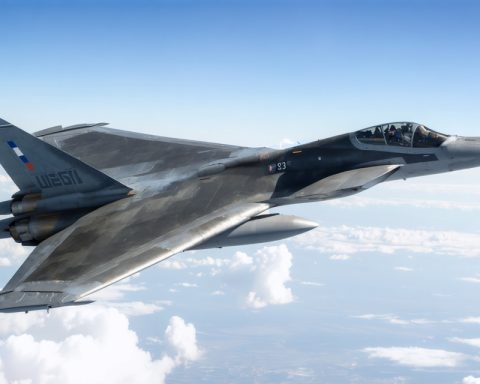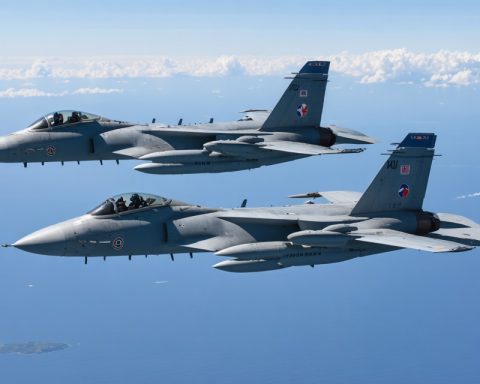- The UAE is ambitiously expanding its military capabilities through potential collaborations with Turkish defense companies.
- Turkey’s KAAN fighter jet, a symbol of advanced aerospace engineering, is central to the collaboration discussions, attracting interest from both the UAE and Saudi Arabia.
- The UAE explores joint projects with Turkey on the Hurkus trainer aircraft, promising enhanced aviation capabilities.
- Renewed discussions around acquiring the Turkish ATAK helicopter reflect the UAE’s focus on strengthening defense ties.
- Turkey’s ANKA-3 unmanned aerial systems are part of future collaboration plans, highlighting shared innovation and technological advancement.
- This partnership signals a potential shift in Middle Eastern defense strategies, as the UAE seeks not just weaponry, but strategic ties with Turkey.
Amid the hustle of Abu Dhabi’s bustling IDEX 2025 defense exhibition, the United Arab Emirates signaled an ambitious expansion of its military prowess, setting sights on collaborative ventures with Turkish defense powerhouses. The desert air crackled with potential as Turkey’s cutting-edge KAAN fighter jet took center stage. More than just a piece of technology, this jet represents a bold leap in military collaboration, drawing the UAE’s interest in potentially reshaping regional alliances.
The stage for burgeoning cooperation was set as UAE officials, with a keen eye for innovation, evaluated the KAAN—a feat of modern aerospace engineering that already entices Saudi involvement. Turkish Aerospace Industries’ CEO Mehmet Demiroglu unveiled a gripping vision: if the UAE climbs aboard, the KAAN project promises to soar to new heights, intertwining the destinies of these nations.
As discussions on the KAAN jet ripple through strategic halls, the air charged with prospects of joint endeavors on the Hurkus trainer aircraft. This partnership aims to elevate the aircraft’s capabilities, reflecting a shared commitment to cutting-edge aviation technology. The imminent formalization of this agreement underscores the tangible progress in this bilateral relationship.
Resonating beyond these projects is the UAE’s renewed interest in the Turkish ATAK helicopter. Once paused, talks of acquisition now gain momentum, fueled by successful prior assessments and high-profile visits. The anticipation builds further as whispers of new aviation systems, powered by Turkey’s ANKA-3 unmanned aerial prowess, hint at a future where shared innovation defines strategy.
In this evolving alliance, a key message emerges: the UAE is not merely buying advanced weaponry; it is crafting a strategic tapestry with Turkey that may redefine defense paradigms across the Gulf. Such moves echo a quest for cutting-edge technology and deeper, resilient cooperation—a signal of shifting sands in the Middle Eastern defense landscape.
The Future of Middle Eastern Defense: UAE-Turkey Alliance Poised to Transform Regional Security
Real-World Use Cases
The potential collaboration between the United Arab Emirates (UAE) and Turkey signifies a pivotal shift in regional defense strategies. The engagements around the KAAN fighter jet, Hurkus trainer aircraft, and ATAK helicopter illustrate direct applications in enhancing military capabilities, from air superiority to advanced training regimes. Such partnerships offer the UAE an opportunity to diversify its defense assets and incorporate cutting-edge Turkish engineering.
Market Forecasts & Industry Trends
The Middle Eastern defense market is experiencing a transformation characterized by regional alliances and diversification away from traditional defense suppliers. According to SIPRI, defense spending in the Middle East is on the rise, with countries seeking modern technologies for robust security. The UAE-Turkey deal could set a precedent, encouraging other neighboring countries to strengthen their defense sectors through local collaborations, thereby accelerating regional military advancements SIPRI.
Features, Specs & Pricing
The Turkish KAAN fighter jet is equipped with state-of-the-art technology. This fifth-generation aircraft boasts advanced stealth capabilities, cutting-edge avionics, and a modular weapon configuration designed to provide strategic flexibility. The pricing details remain confidential, but the investment is indicative of the UAE’s commitment to premium quality and innovation in defense procurement.
Controversies & Limitations
While the promise of UAE-Turkey collaboration is vast, it is not without challenges. Geopolitical tensions, historical alliances, and technology transfer issues could influence the trajectory of this partnership. Some experts caution against over-reliance on new alliances without addressing potential political frictions Carnegie Endowment for International Peace.
Pros & Cons Overview
Pros:
– Enhanced Military Capabilities: Access to advanced Turkish technology such as the KAAN fighter jet and ANKA-3 drones.
– Strategic Alliances: Strengthened bilateral relations, paving the way for future collaborations.
– Diversification: Expanding defense sourcing beyond traditional Western suppliers.
Cons:
– Geopolitical Risks: Navigating potential diplomatic strains with long-standing allies.
– Dependence: Risk of becoming reliant on foreign military technologies.
Insights & Predictions
The UAE-Turkey defense collaboration points toward a consolidated effort in achieving military self-reliance and technological sovereignty in the Gulf region. This partnership could accelerate innovation and regional security, potentially leading to a Middle Eastern defense hub centered around UAE and Turkey’s capabilities.
Actionable Recommendations
– Stay Informed: Regularly follow reputed defense analysis platforms to keep abreast of new developments.
– Strategic Networking: Engage with industry stakeholders at events like IDEX to understand evolving defense needs.
– Diversify Investments: Consider balanced defense procurements portfolio to mitigate geopolitical risks.
In summary, the UAE-Turkey military partnership symbolizes a strategic evolution with far-reaching implications. By embracing collaboration, both nations are poised to redefine the defense landscape in the Middle East, crafting a new narrative of security and technological prowess. For more information on regional defense trends, visit the SIPRI website.








